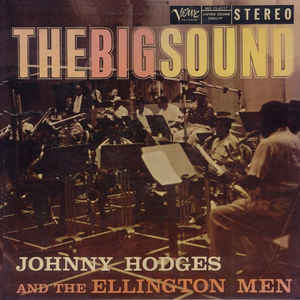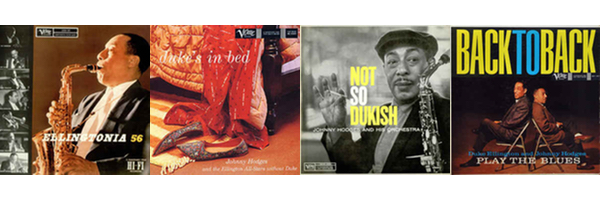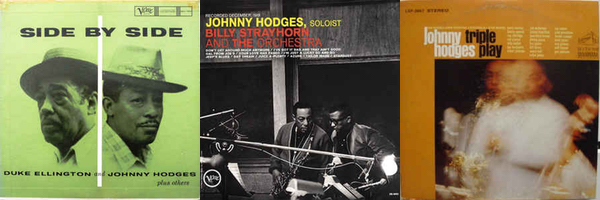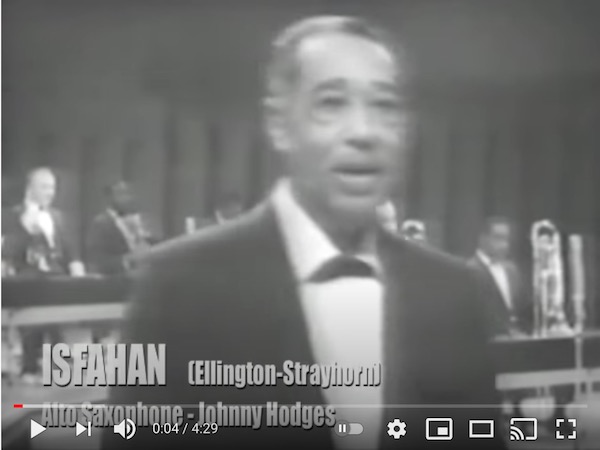The Essential Listening of Johnny Hodges (aka “The Rabbit”)

“One of the most recognizable sounds in all of jazz belongs to Johnny Hodges. As a young saxophonist, Hodges was inspired by the unique sound of his first idol, Sidney Bechet. Hodges said, ‘The reason I was influenced by Bechet is that he seemed quite different from everyone else at the time. The others were trying to copy Benny Carter, Coleman Hawkins, Jimmy Dorsey, etc.: for me it was Bechet.’ Hodges took to heart the development of a style ‘quite different from everyone else’ and we’re all very fortunate that he did. Hodges was instrumental in forging the sound of the Duke Ellington sax section from 1928 on, with a brief hiatus in the early 50s, until his death in 1970.”—Dean Pratt
Vinyl Tap
By Dean Pratt

“He was known by seven different nicknames, including ‘Rabbit,’ ‘Jeep,’ and ‘Squatty Roo.’ He was a short man, only about 5’ 5”, and perhaps as a result became the object of the affectionate put-down that an enduring nickname provides. Hodges was a musical man of mystery, but he could be instantly identified by that most ephemeral of things; a single musical note, one of the few musicians in the history of jazz about whom that could be said as anything other than sheer hyperbole.”—Con Chapman
Author’s Note: My friend Audrey Mannes Mosello put this (vinyl) ball in motion when she asked me to post my favorite albums—my “essential jazz listening list”—on my Facebook wall over a specified period of time. Or something like that. Audrey, you know what you asked of me, but I doubt you expected the deluge that would follow on as a result.

PENDLETON South Carolina—(Weekly Hubris)—February 2021—One of the most recognizable sounds in all of jazz belongs to Johnny Hodges. As a young saxophonist, Hodges was inspired by the unique sound of his first idol, Sidney Bechet. Hodges said, “The reason I was influenced by Bechet is that he seemed quite different from everyone else at the time. The others were trying to copy Benny Carter, Coleman Hawkins, Jimmy Dorsey, etc.: for me it was Bechet.” Hodges took to heart the development of a style “quite different from everyone else” and we’re all very fortunate that he did. Hodges was instrumental in forging the sound of the Duke Ellington sax section from 1928 on, with a brief hiatus in the early 50s, until his death in 1970.
A big fan of his music, I note for you here a few of Hodges’ albums recorded with him as a leader which I have in my collection and continue to enjoy.
Recorded in 1957 for Verve Records, “The Big Sound” consists of three groups: the big band: Willie Cook, Clark Terry, Ray Nance, Cat Anderson, Harold Baker (tpts), Quentin Jackson, John Sanders, Britt Woodman (tbns), Hodges, Paul Gonsalves, Russell Procope, Jimmy Hamilton, Harry Carney (saxs), Billy Strayhorn (piano), Jimmy Woode (bass), and Sam Woodyard (drums); a slightly smaller group minus Anderson, Cook, Baker and Gonsalves; and one more small group with Hodges, Carney, Procope, Hamilton (saxs), Jackson (tbn), Terry, Nance, Baker (tpts), Woode, Strayhorn and Woodyard in the rhythm section. A set of originals by Anderson, Hodges, Strayhorn, and Terry make up this terrific LP.
The 1956 Verve LP “Ellingtonia ‘56” is basically the Ellington band of that year with Billy Strayhorn at the piano. Everyone gets a chance to shine on this one with solos by Clark Terry, Cat Anderson, Willie Cook, and Ray Nance (tpts), Britt Woodman and Quentin Jackson (tbns), Hodges, Harry Carney and Paul Gonsalves (saxs), and Strayhorn, Jimmy Woode, and Sam Woodyard in the rhythm section. As the liner notes state: “This is the sound of the current Ellington band, the sound if you will, of Ellington ‘56.”

So many of Johnny Hodges’ records were stand-outs in the music of my youth. Listening to them today, I’m reminded of a time gone by when I had the great pleasure of seeing and hearing these great artists in person.
The 1957 Verve LP, “Duke’s In Bed,” is one of the albums that most reliably takes me back there. It’s a nonette date featuring, as do all of these albums, Hodges’ sidekicks from the Ellington band: Clark Terry and Ray Nance (tpt/violin), Quentin Jackson (tbn), Hodges (alto), Jimmy Hamilton (clarinet), Harry Carney (baritone), and Strayhorn, Woode and Woodyard in the rhythm section. I love this LP! It comprises originals by Hodges (“A Oddie-Oobie,” “Meet Mr. Rabbit,” “Confab With Rab”), Strayhorn (“Take The A Train,” “Ballade For Very Tired And Very Sad Lotus Eaters”), Ellington (“Duke’s In Bed,” “Black and Tan Fantasy”), Fats Waller’s “Just Squeeze Me,” and the Isham Jones/Gus Kahn tune, “It Had To Be You.” Get it!
“Not So Dukish,” recorded in 1958, is another nonette date with Roy Eldridge and Ray Nance (tpt), Lawrence Brown (tbn), Jimmy Hamilton (cl), Ben Webster (tenor), Hodges (alto), Strayhorn, Woode and Woodyard in the rhythm section. Of course, the title is tongue in cheek and this album continues Johnny Hodges’ studio dates for Norman Granz’s Verve label with another set of swinging originals by Johnny, Billy Strayhorn, Jimmy Hamilton and the title track, composed by bassist Jimmy Woode.
Two of the best small group recordings in jazz are up next: “Back to Back, Duke Ellington and Johnny Hodges Play The Blues,” and “Side by Side, Duke Ellington and Johnny Hodges,” recorded in 1959 and 1960. I’ve worn these two out. “Back to Back” finds Harry Edison (tpt), Hodges (alto), Les Spann (guitar), Al Hall and Sam Jones (bass), Jo Jones (drums) and Ellington (piano). A set of classic traditional blues numbers get the Ellington/Hodges treatment: “Wabash Blues,” “Basin Street Blues,” “Beale Street Blues,” “Weary Blues,” “St. Louis Blues,” “Loveless Love,” and “Royal Garden Blues.” Grab a glass of wine, set the lights on low, sit back and enjoy.
“Side By Side” features the same group on “Stompy Jones,” “Squeeze Me,” and “Going Up”: the rest of the LP has the same personnel from the “Not So Dukish” date except for Wendell Marshall (bass). Highlights are solos by Eldridge, Webster, and the leader. Make sure you have these two on your desert island list.

Recorded in December of 1961 by master engineer Rudy Van Gelder, “Johnny Hodges, Billy Strayhorn and The Orchestra” finds Billy Strayhorn as arranger/conductor fronting the 1961 Ellington band: Shorty Baker, Cat Anderson, Bill Berry, Ed Mullens (tpts), Lawrence Brown, Quentin Jackson, Chuck Connors (tbns), Hodges, Russell Procope, Paul Gonsalves, Jimmy Hamilton, Harry Carney (saxs), Jimmy Jones (piano), Aaron Bell (bass), and Sam Woodyard (drums). As Stanley Dance affirms the old adage in his notes—“You can never have too much of a good thing”— it was in that spirit that this album was conceived. Some of the good things performed here are: “Don’t Get Around Much Anymore,” “I’ve Got It Bad,” “Gal from Joe’s,” “Azure,” “Jeep’s Blues,” “Stardust,” and “Day Dream,” “I’m Just A Lucky So And So.”
Finally, recorded in 1967 for RCA, “Triple Play” is a set of mostly Hodges originals played by three different small groups, including: Cat Anderson, Ray Nance, Roy Eldridge (tpts), Lawrence Brown, Benny Powell, Buster Cooper (tbns), Hodges, Jimmy Hamilton, Paul Gonsalves, Harry Carney (saxs), Jimmy Jones, Nat Pierce, Hank Jones (piano), Les Spann, Tiny Grimes, Billy Butler (guitar), Bill Berry (Vibes), Milt Hinton, Aaron Bell, Joe Benjamin (bass), Gus Johnson, and Oliver Jackson, Rufus Jones (drums). Ballads, blues and swinging originals by three distinctive groups make for a unique blend of small group jazz.
All essential listening, Audrey!
https://www.youtube.com/watch?v=hGZDRQUSMmE

One Comment
Jean
Oh, Dean, boy, did you take me back! My mom had The Big Sound, Ellingtonia 56, and Back to Back. She adored Bechet, so now, thanks to your knowledge, I know why she loved Hodges. And I had totally forgotten Billy Strayhorn. So, my friend, thank you. I am off to buy Back to Back…